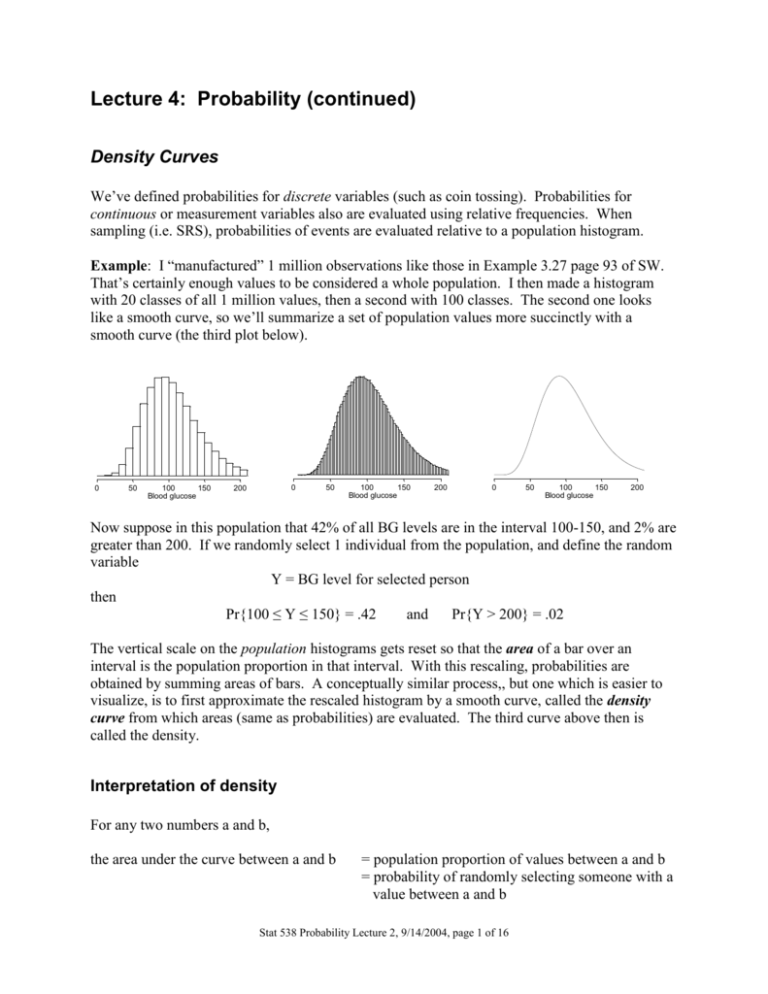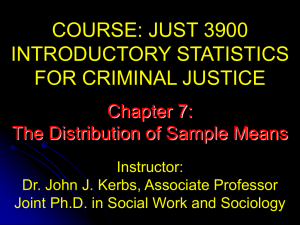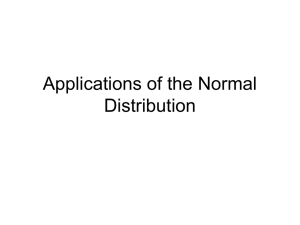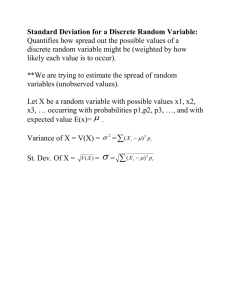Lecture 3: Introduction to Probability
advertisement

Lecture 4: Probability (continued)
Density Curves
We’ve defined probabilities for discrete variables (such as coin tossing). Probabilities for
continuous or measurement variables also are evaluated using relative frequencies. When
sampling (i.e. SRS), probabilities of events are evaluated relative to a population histogram.
Example: I “manufactured” 1 million observations like those in Example 3.27 page 93 of SW.
That’s certainly enough values to be considered a whole population. I then made a histogram
with 20 classes of all 1 million values, then a second with 100 classes. The second one looks
like a smooth curve, so we’ll summarize a set of population values more succinctly with a
smooth curve (the third plot below).
0
50
100
150
Blood glucose
0
200
50
100
150
Blood glucose
200
0
50
100
150
Blood glucose
200
Now suppose in this population that 42% of all BG levels are in the interval 100-150, and 2% are
greater than 200. If we randomly select 1 individual from the population, and define the random
variable
Y = BG level for selected person
then
Pr{100 ≤ Y ≤ 150} = .42
and
Pr{Y > 200} = .02
The vertical scale on the population histograms gets reset so that the area of a bar over an
interval is the population proportion in that interval. With this rescaling, probabilities are
obtained by summing areas of bars. A conceptually similar process,, but one which is easier to
visualize, is to first approximate the rescaled histogram by a smooth curve, called the density
curve from which areas (same as probabilities) are evaluated. The third curve above then is
called the density.
Interpretation of density
For any two numbers a and b,
the area under the curve between a and b
= population proportion of values between a and b
= probability of randomly selecting someone with a
value between a and b
Stat 538 Probability Lecture 2, 9/14/2004, page 1 of 16
Area = Pr{a ≤ Y ≤ b}
0
a
50
100
Blood glucose
b
150
200
1 = Total Shaded Area
0
50
100
150
Blood glucose
200
.42 = Pr{100 ≤ Y ≤ 150} for BG problem
0
50
100
Blood glucose
150
200
Example: SW example 3.30 p. 95
Stat 538 Probability Lecture 2, 9/14/2004, page 2 of 16
Binomial Distribution
This is a special discrete probability distribution. We need to understand it to understand
statistical techniques such as logistic regression.
Independent Trials Model for Binomial Experiment
A series of n trials
Each trial results in 1 of 2 outcomes, called Success and Failure (generic names)
The probability of success, called p, is the same for each trial
The outcomes of the trials are assumed to be independent
Example:
Toss a coin 5 times
Outcome for each trial (toss)
H (call it success)
T (call it failure)
Suppose coin is fair, so p = Pr{H} =.5
Example:
SW example 3.42 p. 103
The binomial distribution specifies a formula for evaluating the probability distribution
associated with the number of successes in a binomial experiment. In the previous problem,
n = 2 and, if we define Y = No. of Albino Children, we can directly evaluate this distribution, but
it is much harder to do with trees if n is large (too many branches).
Definitions
For any positive integer x define x ! 1 2 3
What is 2!? 3!? 5!?
( x 1) x . This is called x-factorial.
Also define 0! = 1
The binomial coefficient n C j is defined as n C j
n!
j !( n j )!
(note: we will always
have n ≥ j).
Table 2 of SW p. 674 gives binomial coefficients. Notice how fast they get large.
The Binomial Distribution Formula
For a binomial experiment, the probability of exactly j successes in n trials (so n-j failures) is
Pr( j Successes} n C j p j (1 p)n j ,
j 0,1,2,..., n
Example: 3.45 p. 106 of SW
Example: 3.47 p. 108 of SW
Stat 538 Probability Lecture 2, 9/14/2004, page 3 of 16
Mean and Standard Deviation of the Binomial
If Y = No. Successes in a binomial experiment with n trials and probability of success = p, then
the mean (or expected value) is np and the standard deviation is np(1 p) . If we were
to repeat the experiment a huge number of times, each time recording the number of successes,
we would have a huge collection of integers between 0 and n. The preceding formulas give the
mean and standard deviation we would calculate from that huge collection.
Example: 3.47 p.108 revisited. Here n = 6 and p = .85, so expected no. of Rh+ is 6(.85) = 5.10
and the standard deviation is 6(.85)(.15) .87 . Note that the expected value is not necessarily
something that is observed!
The Normal Distribution
SW Chapter 4, Sections 1-4
The normal or bell-shaped distribution plays an important role as an approximation to certain
discrete and continuous distributions, but is also useful as an approximate density curve for
certain populations.
Example: SW example 4.1 p. 119.
Example: SW example 4.2 p. 120.
Normal Curves
The preceding examples illustrate two important properties of normal distribution or curves
There are many distinct normal curves
The normal curve that approximates a population histogram is indexed by the mean and
standard deviation of the population, labeled µ and σ, respectively.
Note that normal curves are centered at µ and the spread of the distribution is controlled by the
size of σ (i.e. larger σ implies less probability near µ).
Smaller σ
Two normal curves with same std. dev.,different means
Two normal curves with same means,different std. dev.
Stat 538 Probability Lecture 2, 9/14/2004, page 4 of 16
.5
y
2
1
e
2
We will see presently how to evaluate probabilities for normal distributions. The following
diagram does show some of the most important areas (approximately).
The functional form for a normal density curve is f ( y )
µ - 2σ
µ - 3σ
µ-σ
µ
µ+σ
µ + 2σ
µ + 3σ
68%
95%
99.7%
Standard Normal Distribution
The standard normal curve corresponds to a normal distribution with mean 0 and standard
deviation 1. The letter Z (for Z-score) is used to identify a standard normal variable.
All normal distributions can be related to the standard
normal through the so-called z-score transformation, which
allows one to calculate probabilities for arbitrary normal
distributions as areas under the standard normal curve.
-3 -2 -1
0
z
1
2
3
Stat 538 Probability Lecture 2, 9/14/2004, page 5 of 16
Areas under the standard normal curve
SW Table 3 p. 675-6, but more conveniently on the inside front cover, gives lower-tailed areas
under the Z-curve of the form
Area under curve for all values ≤ z
-3
-2
-1
0
1
2
3
z
In the table z ranges from -3.49 to 3.49, although it is positive above.
Example: If z = 0.47, then
Area under curve = .6808
This picture also tells you the
area to the right of 0.47. How?
It also tells you the area to the
right of -0.47. How?
-3
-2
-1
0
1
2
It also tells you the area to the
left of -0.47. How?
3
z = 0.47
We exploit symmetry extensively to use these tables, i.e. lower tailed areas can be used to
compute upper tailed areas. We also use the fact that the total area under the curve is 1.
Example:
Area under curve right of -1.47 can be computed two
ways. It is the same as the area to the left of +1.47, or
.9292. It also is the 1-area left of -1.47, or 1-.0708, which
also is .9292. The first way probably is most direct; the
second can be easiest sometimes.
-3
-2
-1
0
1
2
3
z = -1.47
Stat 538 Probability Lecture 2, 9/14/2004, page 6 of 16
We find central areas by subtracting:
=
-3
-2
-1
0
1
2
-
-3
3
-2
z = 1.23
z = -1
Desired area
-1
0
1
2
3
-3
z = 1.23
=
-2
-1
0
1
2
3
z = -1
.8907
-
.1587 = .7320
Comments
1. Always draw a picture
2. Recognize symmetry about 0 (area to left of 0 = area to right of zero = .5)
3. Areas are probabilities. If Z is a standard normal variable then we computed in the three
examples
(a)
Pr{Z ≤ .47} = .6808
(b)
Pr{Z ≥ -1.47} = .9292
(c)
Pr{-1 ≤ Z ≤ 1.23} = .7320
Example: compute Pr{Z ≥ 2.12}. Draw a picture!
Using the standard normal table we can show, for a Z, that the following areas are true. These
imply the more general result on page 5. We will return to this shortly.
Stat 538 Probability Lecture 2, 9/14/2004, page 7 of 16
-1
-2
-3
σ
0
1
2
3
Z
68%
95%
99.7%
Areas for General Normal Curves
Suppose for a certain population of herring, the lengths of individual fish follow a normal
distribution with mean 54 mm and standard deviation 4.5 mm (population mean and std. dev.).
What percent of fish has length less than or equal to 60 mm?
Let Y = length of randomly selected fish. Then the percent of interest is just Pr{Y ≤ 60}. The
picture is
Normal Curve µ = 54 and σ = 4.5
54
60
0
1.33
Y
Z
To get the area of interest we use the Z-score transform Z
Y
to create a standard normal
variable from Y. We then convert the limits of the area from the Y-scale to the Z-scale in the
60 60 54
1.33 . We then compute the
same manner. That is for y = 60, z
4.5
corresponding area under the Z-curve using Table 3,
Stat 538 Probability Lecture 2, 9/14/2004, page 8 of 16
Area = .9082
1.33
Z
Symbolically,
Pr{Z ≤ 1.33} = Pr{Y ≤ 60} = proportion of fish with length ≤ 60 mm = .9082 = 90.82%.
What percentage of fish is more than 45 mm long?
Follow steps 1-2-3
1 – draw a picture of
desired area
45
54
Y
2 - Transform
Z
3. area = 1-.0228
-2
to z-score scale
0
= .9772
For y = 45: z
45 54 9
2
4.5
4.5
i.e. Pr{Z ≥ -2} = Pr{Y ≥ 45} = proportion of fish ≥ 45 mm = .9772 = 97.72%.
Let us work out, together, the following problem: What proportion of fish is between 56 and 62
mm long?
1 – 2 – 3 SD rule
The Z-score tells us how many standard deviation (SD) units a value is from the mean. For
( 2 ) 2
2.
example, y 2 is a value 2 standard deviations above µ, so z
( )
1 . The
Similarly y is a value 1 standard deviation below µ, so z
1 – 2 – 3 SD rule says that for a normal population,
Stat 538 Probability Lecture 2, 9/14/2004, page 9 of 16
68% of values are within 1 std dev of µ (i.e. in ( , ))
95%
2
(i.e. in ( 2 , 2 ))
99.7%
3
(i.e. in ( 3 , 3 ))
This follows from a direct transformation of interval endpoints to z-scores.
µ - 3σ
-3
µ - 2σ
-2
µ-σ
µ
µ+σ
µ + 2σ
-1
0
1
2
µ + 3σ
3
Y
Z
68%
95%
99.7%
In essence, this result implies
1. That the distance from the center is best measured in terms of multiple of standard
deviations (i.e. Z-scores).
2. The standard deviation determines how “extreme” or unusual a value is.
Example: Fish lengths. Here µ = 54 mm and σ = 4.5 mm
68 % of fish have lengths between 54 – 4.5 and 54 + 4.5, or 49.5 and 58.8
95%
54 – 2(4.5) and 54 + 2(4.5), or 45 and 63
99.7%
54 – 3(4.5) and 54 + 3(4.5), or 40.5 and 67.5
Example: SW exercise 4.3 (a) – (c) p. 131.
Stat 538 Probability Lecture 2, 9/14/2004, page 10 of 16
Percentiles of Normal Distributions
These are “inverse problems” where you are given an area and need to find a value that will
produce it (instead of the “direct” problem of finding an area like we have been doing).
The pth percentile for a probability distribution is the value such that there is probability p of
being less than or equal to that value, and probability 1-p of being greater. The picture below
identifies the placement of the pth percentile for a normal distribution.
Area = p
Area = 1 - p
Y
pth percentile (y*)
To compute this percentile, we first compute the pth percentile for a standard normal
Area = p
Y
Z
z
This can be obtained by an inverse process from what we’re used to. Given the standard normal
percentile we solve for the y-value that gave rise to it:
z
y *
y* z
Examples (fish lengths, revisited):
What is the 40th percentile of the fish length distribution?
What length must a fish be so that only 5% have longer lengths?
Example: SW ex 4.16 p. 133
Stat 538 Probability Lecture 2, 9/14/2004, page 11 of 16
Sampling Distributions
Read SW Chapter 5, Sections 1-4
Suppose that I wish to know what the mean is for a specific population (target or study
population. The following diagram summarizes the sampling from the population.
Random sample
SRS of n
Y1 ,
Population of interest
Mean µ (unknown)
The pop. is what we’re interested
in but cannot see completely.
, Yn .
Calculate Y
n
i 1
n
Yi
as best
guess for µ. This is our data. We’re
interested in the population, but this
small snapshot is all we have to work
with.
Important points
The sample mean Y estimates µ, but there is error associated with the estimate (we
would need to access the whole population to exactly calculate µ).
Different samples give different Y ’s, so the size of the error depends upon the sample.
Of course in practice we don’t know if we got a “good” sample or a “bad” one (i.e. we
don’t know if Y is close to µ or not).
The value of Y cannot be predicted prior to the sample being selected, so before collecting data
we think of Y as being a random variable. On a conceptual level we can envision listing all
possible samples of size n and the Y that results. The collection of sample means that is
obtained can be collected and plotted as a histogram, leading to what is commonly called the
sampling distribution of the sample mean Y . The sampling distribution of Y is, in essence, a
probability distribution of Y that specifies the probability of observing specific ranges of values
for Y when we sample the population.
The sampling distribution is real but is mostly a conceptual construct. We can list the sampling
distribution only if we know the population values. If we knew the population distribution we
would not need to sample it! Nonetheless, the idea of the sampling distribution is crucial to
understanding the accuracy of Y .
Stat 538 Probability Lecture 2, 9/14/2004, page 12 of 16
Meta - Experiment
Histogram of possible Y ’s
Y
Density
Curve
Y
Y
Pop
.
.Y
.
.
.
Y
Different samples, different Y ’s
The following properties of the sampling distribution of Y can be shown mathematically:
If we have a SRS from a population with mean µ and standard deviation σ, then
1. The average or mean in the sampling distribution of Y is the population mean µ. In
symbols, Y (the mean of the mean is the mean?)
2. The standard deviation of the sampling distribution of Y is the population standard deviation
divided by the square root of the sample size n. In symbols, Y
n
.
3. Shape of sampling distribution
a) If the population distribution is normal, then the sampling distribution of Y is normal,
regardless of n.
b) Central Limit Theorem: If n is large, the sampling distribution of Y is normal, even if
the population distribution is not normal.
Important points
1. The “typical error” in Y as an estimate of µ is 0.
2. The accuracy of Y increases with sample size (i.e. smaller variability in sampling
distribution).
Stat 538 Probability Lecture 2, 9/14/2004, page 13 of 16
3. For a given sample size, Y will be less accurate for populations with larger standard
deviation σ.
4. Knowing that the shape of the sampling distribution is normal, or approximately normal,
allows one to evaluate probabilities for Y .
These ideas are fairly subtle but important. Let us go through a number of examples in the text.
Examples:
SW example 5.8 p. 158
SW example 5.9 p. 159
SW example 5.10 p. 161
5.11 p. 162
5.12 p. 163
5.13 p.167
5.14 p.168
Dichotomous observations
Dichotomous = binary (successes or failures)
Suppose we select a SRS of size n from a population and count the number of “successes” or
individuals in the sample with a given characteristic. We know this has a Binomial distribution.
As an alterative way to summarize the data, we might consider the sample proportion p̂ , where
p̂ = # successes / n. If the population proportion of successes is p, we can show that the
sampling distribution of p̂ has
1. Mean = p
p(1 p )
n
3. Shape that is approximately normal for large n
2. Standard deviation =
These results can be used to approximate binomial probabilities using a normal distribution.
Example: SW example 5.16 p. 171.
I do not want to overemphasize probability calculations based on sampling distribution. The
important place for sampling distributions is where they directly lead to procedures for statistical
inference.
Stat 538 Probability Lecture 2, 9/14/2004, page 14 of 16
Confidence Intervals
SW Chapter 6
Course notes p 20-26
This chapter introduces a standard statistical tool, the confidence interval, which will be used to
estimate unknown population means µ and proportions p.
Standard Errors of the Mean
Given a SRS of size n from a population with unknown mean µ and standard deviation σ, our
best guess for µ is the sample mean Y
n
i 1
n
Yi
. The accuracy of Y as an estimate of µ is
dictated by the size of the standard deviation of the sampling distribution of Y , Y
. In
n
practice this quantity is unknown (we don’t know σ), but can be estimated by using the sample
standard deviation S as an estimate of σ. This leads to the so-called standard error of Y ,
s
as an estimate of Y .
SEY
n
Example:
SW ex 6.3 p 181
SW ex 6.5 p.183-4
The Student’s t-distribution
If the population standard deviation σ were known, then a Z-score transformation of the
Y Y Y
sampling distribution of Y , i.e. Z
could be used to generate confidence
Y
n
intervals for µ, and this idea is illustrated by SW on p. 186. Because σ is unknown in practice,
we need an alternative approach and that is to standardize Y by using SEY instead of Y ,
Y Y Y
. If the population we sampled from
SEY
s n
is normal, then Z is standard normal and t has the so-called t-distribution.
computing a t-score instead of a z-score, t
The density curve for a t-distribution looks like a bell-shaped curve, but has more probability in
the tails than the Z-distribution. Furthermore, there are many t-distribution, but the family or
collection of t-distributions is indexed by one parameter called the degrees of freedom (df). For
our problem the df = n-1. As df increases the t-density curve more closely resembles a standard
normal curve. For df = ∞ (infinity) the t-curve is the standard normal curve. See Figure 6.7 p.
187 of SW.
Stat 538 Probability Lecture 2, 9/14/2004, page 15 of 16
For our applications we will need upper tailed critical values from the t-distribution of the form
Area = α
0
t
t
0
Table 4 (inside back cover) gives upper tail critical values.
Example: for df = 10 find t.05, t.025, t.01 Repeat for df = 3
Question: For a given upper tail area, how do critical values change as df increases? What do
you get when df = ∞?
Stat 538 Probability Lecture 2, 9/14/2004, page 16 of 16







